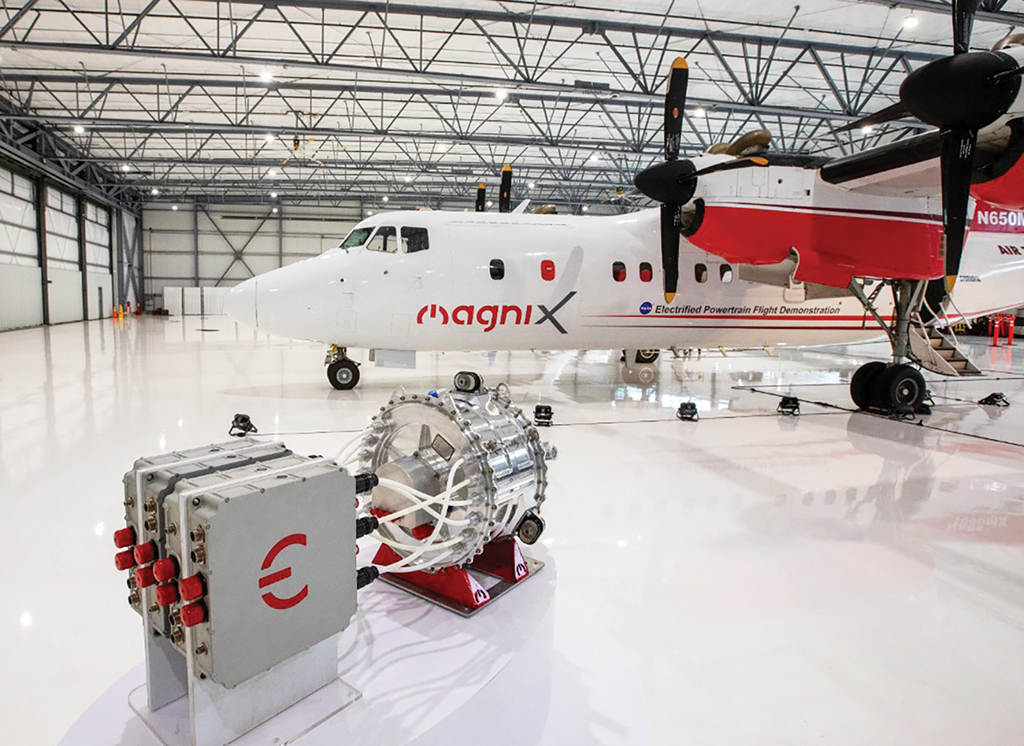This article is published in Aviation Week & Space Technology and is free to read until May 14, 2025. If you want to read more articles from this publication, please click the link to subscribe.

Bye Aerospace says its two-seat electric trainer can cut operating costs by 80% compared with conventional trainers.
The political pressures that have been pushing for aviation decarbonization are suddenly receding.
The new Trump administration has drastically deprioritized environmental initiatives, clearing the way for a possible boom in oil and gas production while dealing a blow to proponents of alternative energy. Acknowledging where the political winds are blowing, the International Air Transport Association in March signaled its intent to walk back its commitment to achieve net-zero CO2 emissions by 2050 (AW&ST March 10-23, p. 14).
- Economics, not sustainability, is driving electric innovation
- Advanced aviation companies are unfazed by shifting government priorities
Although the airline industry appears to have slammed the breaks on sustainability, the burgeoning advanced air mobility sector seems not to have gotten the message. In conversations on the sidelines of the 2025 McKinsey Regional Air Mobility Summit on March 28 in San Francisco, executives from electric aviation startups shrugged off the suggestion of an industrywide retrenchment on sustainability.
While sustainability remains a welcome byproduct of electric aviation, these executives insisted that their main pitch to potential customers and investors is improved efficiency, reliability and maintainability, because these factors—when combined with the lower cost of electricity versus fuel—drive operating costs substantially lower than for conventional aircraft.
“Sustainability is really a nice byproduct of what we’re doing, but in aviation, the cost structure is the most important,” said David Stepanek, executive vice president and chief transformation officer at Bristow Group, which has placed orders for a range of electric and hybrid aircraft from such companies as Beta Technologies and Vertical Aerospace. “In this case, going electric allows us to build viable business models with technology that exists today, and it’s going to cost less. You throw in geographic barriers, and it’s going to cost less than road transportation in many cases. So the message is: ‘Let’s focus on building a sustainable business case that is also sustainable from an environmental standpoint.’”
Marc-Henry de Jong, co-founder and chief commercial officer of Dutch startup Electron Aircraft, echoed that sentiment, arguing that a substantial portion of short-haul flying can be done more cheaply with existing batteries than with jet fuel. His main pitch to customers and investors: The higher acquisition cost of electric aircraft can be quickly amortized, given their low operating costs.
“We never led with the environmental credentials—it was just an added benefit,” de Jong said. “By going battery-electric, we tackle two of the biggest cost factors: the fuel cost and the maintenance cost. . . . It’s great to show a picture of a tiny eVTOL [electric vertical-takeoff-and-landing] that looks really sexy, but the more important question is: ‘Can it make money?’ Because that’s what our investors really want. Being green is a bonus.”

Given the limitations of batteries, many startups are looking at the lower segments of the market as a launching ground for electrification. Colorado-based Bye Aerospace is developing the EFlyer 2, a two-seat electric trainer. The company says reducing operating costs by up to 80% versus conventional trainers could allow flight schools to double, or perhaps triple, their historically slim profit margins.
“That’s what the training industry needs—a simpler aircraft that’s reliable and flies at much lower cost than the current aircraft in the training fleet,” Bye Aerospace CEO Rod Zastrow said.
The economic argument is even greater for the startups that are designing powertrains as retrofits to existing aircraft. David Doral, co-founder and CEO of Spanish-Australian startup Dovetail Electric Aviation, said that electrification work for a Cessna Caravan can be completed for $1.5 million, compared with roughly $500,000 for a typical engine overhaul. Assuming a 40% improvement in operating costs, Doral estimated that operators could recoup the $1 million difference within three years.
MagniX Chief Technology Officer Riona Armesmith agreed that reducing costs—not emissions—will be the largest driver of industry adoption, while government incentives will ultimately fail to move the needle. The company estimates its electric powertrains can achieve cost savings of up to 80% compared with conventional turboprop engines.
“I don’t think legislation that forces higher costs on carbon is going to work if you can’t actually provide a new technology that is lower-cost to operate,” Armesmith said.
To be sure, attractive operating economics are not the only selling point—excluding emissions reductions—of electric aviation. Noise, or lack thereof, is another key unlock even in nonurban environments. Mark Moore, an industry pioneer at NASA and Uber Elevate and co-founder and CEO of quiet-electric-propulsion startup Whisper Aero, believes noise reduction will be among the critical factors that encourage widespread adoption.
“I agree that sustainability, especially with this new administration, is probably not going to get you funding right now,” Moore said. “But the big thing that I learned from Uber [Elevate] was if you want compelling economics, it’s all about getting to scale. I can tell you right now, this industry does not get to scale unless it’s quiet—either urban or regional air mobility.”
Like the other executives Aviation Week interviewed, Moore agreed that sustainability alone is not a particularly persuasive pitch. “Look, if all you can offer as a value proposition is sustainability, that’s not enough,” he said. “You’ve got to really have compelling economics for any company to be successful.”
While the recent backpedaling on sustainability has undoubtedly harmed the commercial airline industry’s drive to net-zero CO2 emissions, that retrenchment does not appear to have dented morale in the legions of startups pursuing electric, hybrid and even hydrogen-powered aircraft.
It is impossible to predict which way the political pendulum will swing in the coming years. Even without any meaningful political or consumer pressures, however, operators could end up going green—but only when they think it makes good business sense.





